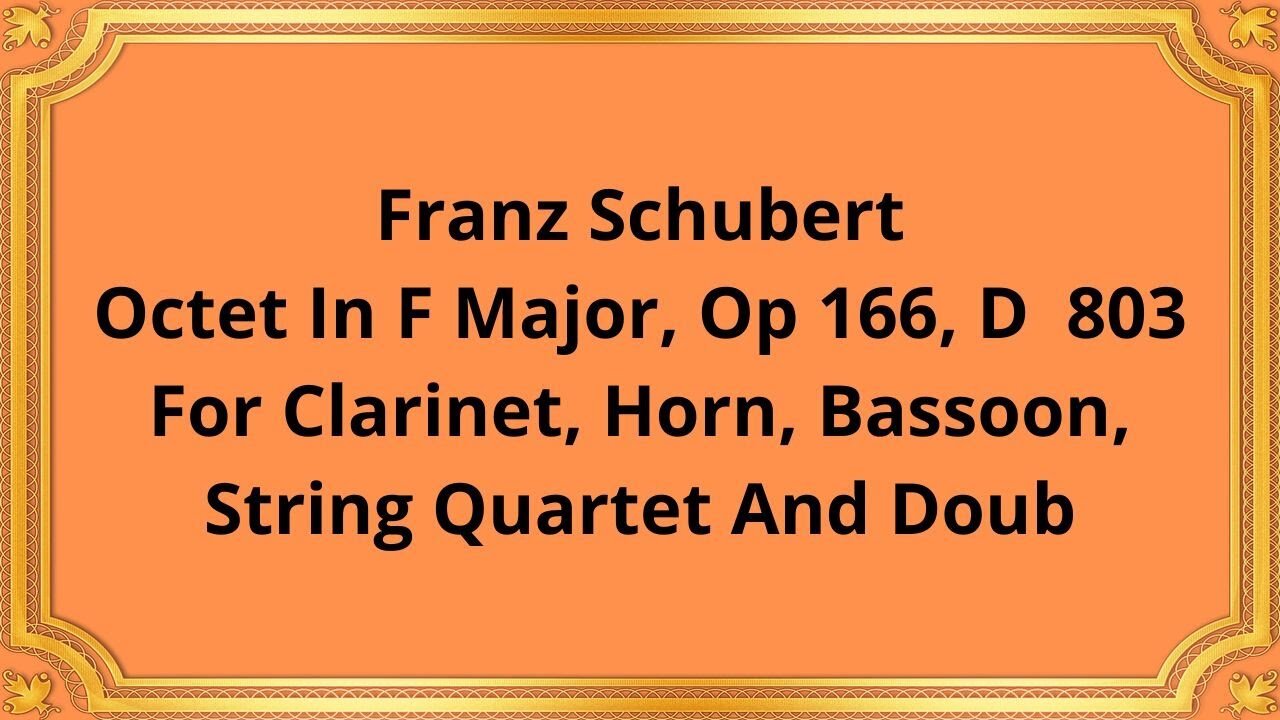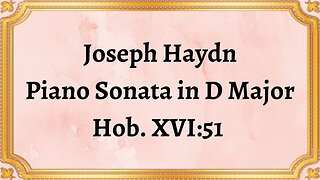Premium Only Content

Franz Schubert Octet In F Major, Op 166, D 803 For Clarinet, Horn, Bassoon, String Quartet And Doub
#FranzSchubert #Octet #ClassicalMusic #MusicalComposition #FMajor #Op166 #D803 #Clarinet #Horn #Bassoon #StringQuartet #DoubleBass
THE VIRTUOSO ENSEMBLE
violins: David Martin, Patrick Halling; viola: Gwynne Edwards;
cello: Willem de Mont; bass: James W. Merrett; clarinet:
Sidney Fell; horn: John Burden; bassoon: Ronald Waller
Franz Schubert, a prominent composer of the Romantic era, showcased his exceptional talent and creativity through numerous masterpieces. Among his remarkable works, the Octet in F Major, Op 166, D 803 holds a special place.
Composed in 1824, Schubert's Octet in F Major marked a departure from traditional chamber music. At the time, chamber music primarily consisted of smaller ensembles, but Schubert pushed boundaries by composing for a larger ensemble. The Octet reflects the composer's desire to experiment with form and instrumentation, resulting in a truly unique and groundbreaking composition.
Schubert's Octet is scored for an ensemble comprising clarinet, horn, bassoon, string quartet, and double bass. This dynamic combination allows for a rich and diverse range of timbres, enabling the composer to create intricate musical textures and explore a wide spectrum of emotions.
1. Adagio - Allegro: The Octet opens with a majestic Adagio introduction, gradually building anticipation before transitioning into the energetic Allegro. This movement showcases Schubert's gift for melody and his ability to seamlessly transition between contrasting musical ideas.
2. Adagio: The second movement, Adagio, unfolds with a lyrical and expressive melody that is passed between different instruments. This movement demonstrates Schubert's command over the emotional depth of his compositions, evoking a sense of introspection and contemplation.
3. Allegro vivace - Trio: The third movement, Allegro vivace, is a lively scherzo that showcases Schubert's playful and rhythmic writing. The contrasting Trio section provides a momentary respite before returning to the energetic main theme.
4. Andante - Menuetto: The fourth movement begins with a tender Andante section, characterized by its delicate melodies and serene atmosphere. The Menuetto follows, featuring a spirited dance-like rhythm, further highlighting Schubert's ability to seamlessly merge contrasting musical styles.
5. Andante molto - Allegro - Andante molto: The final movement is a tour de force, consisting of a set of variations on a theme from Schubert's own song, "Die Forelle." This movement exemplifies Schubert's virtuosity as a composer, as he skillfully weaves together variations of the theme, showcasing the talents of each instrument in the ensemble.
Schubert's Octet in F Major has enjoyed enduring popularity and has become a staple in the chamber music repertoire. Its innovative instrumentation, melodic richness, and emotional depth have captivated audiences for generations. The Octet's influence can be seen in subsequent works composed for larger chamber ensembles, inspiring composers to explore new possibilities in the realm of chamber music.
Conclusion:
Franz Schubert's Octet in F Major, Op 166, D 803 is a testament to the composer's genius and innovative spirit. Its historical significance, unique instrumentation, structural elements, and lasting impact on the world of classical music have solidified its place as a remarkable composition. As we immerse ourselves in the harmonious ensemble of the Octet, we are reminded of Schubert's ability to push boundaries, create timeless melodies, and leave an indelible mark on the world of music.
You have the opportunity to support the channel:
https://destream.net/live/RadSiarAl/donate
https://www.buymeacoffee.com/6355radsiaral
-
 6:07
6:07
Classical music_Music Inspiration
25 days agoJoseph Haydn Piano Sonata in D Major, Hob. XVI:51
721 -
 11:08
11:08
China Uncensored
6 hours agoXi Jinping's Greatest Fear
6.05K4 -
 LIVE
LIVE
I_Came_With_Fire_Podcast
12 hours agoFar Left TROJAN HORSE | SPECIAL Forces in MEXICO | GERMANY under FIRE
167 watching -
 1:41:00
1:41:00
Darkhorse Podcast
9 hours agoIf Only We’d Known: The 265th Evolutionary Lens with Bret Weinstein and Heather Heying
101K31 -
 1:58:29
1:58:29
Conspiracy Pilled
3 days agoThe Vaccine Conversation (S5 - Ep17)
35.9K -
 11:22
11:22
Tundra Tactical
5 hours ago $0.39 earnedUSA vs Canada HOCKEY Fight: The Real PRIDE Fighting.
46.5K3 -
 54:43
54:43
LFA TV
1 day agoWhy Exposing Waste and Fraud Terrifies the Beltway | TRUMPET DAILY 2.19.25 7PM
44.6K5 -
 1:01:13
1:01:13
Candace Show Podcast
7 hours agoBlake Lively's BOMBSHELL Legal Filing | Candace Ep 149
114K130 -
 1:11:22
1:11:22
Vigilant News Network
10 hours agoElon Musk Shuts Down RFK Jr. Critics With One Powerful Statement | The Daily Dose
76.5K28 -
 1:12:23
1:12:23
Dad Dojo Podcast
22 hours ago $1.60 earnedEP20: The Super Bowl and Solving The Economy
43.8K